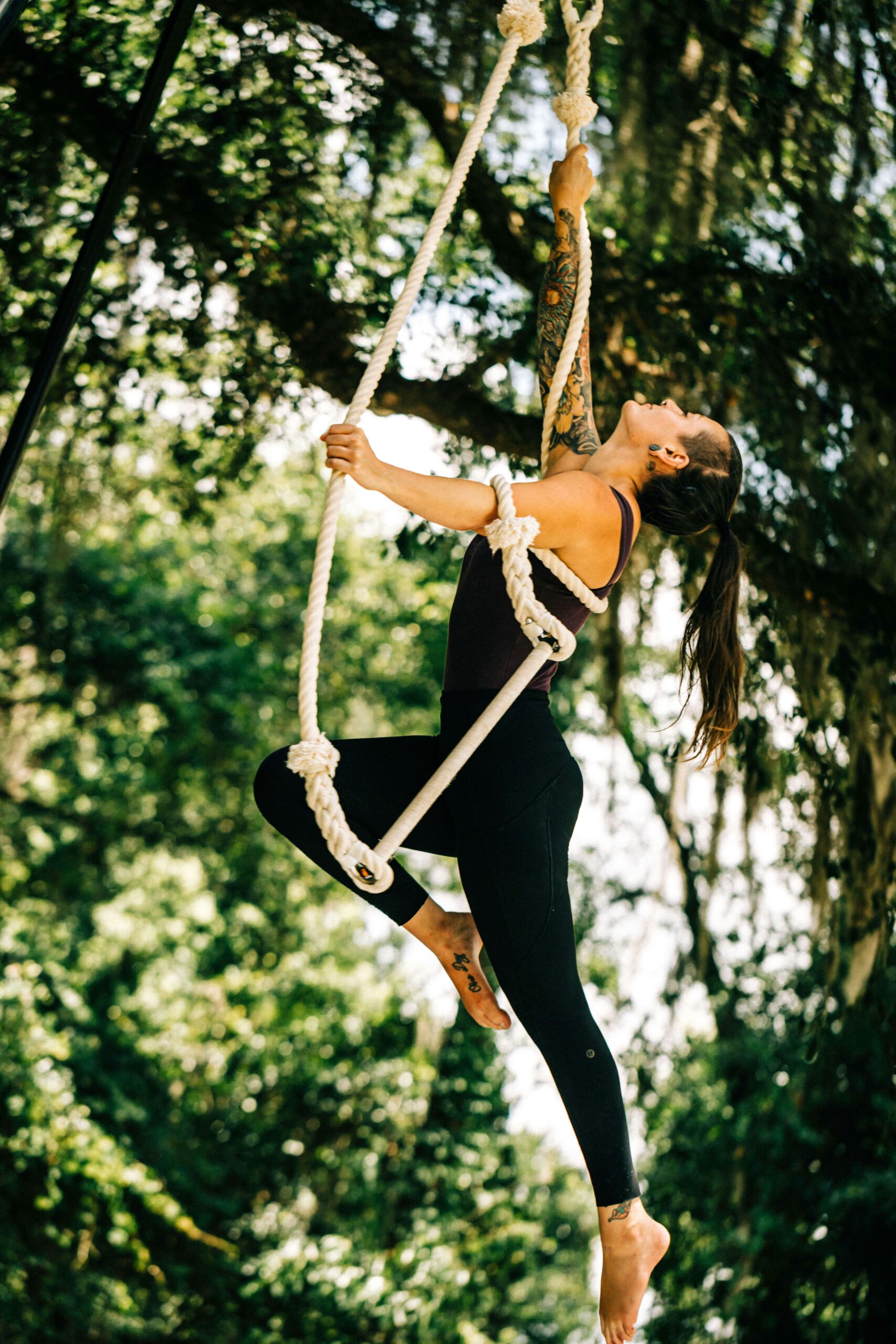
The Transformative Benefits of Aerial Fitness: A Comprehensive Guide
- The Rise of Aerial Fitness: Benefits, Tips, and Why It’s Taking the Fitness World by Storm
- The Transformative Benefits of Aerial Fitness: A Comprehensive Guide
Aerial fitness has soared in popularity, captivating fitness enthusiasts with its blend of strength, grace, and creativity. Whether you’re suspended on a silk hammock, trapeze, or hoop, this dynamic workout offers a full-body experience that transcends traditional exercise. From building muscle to boosting mental clarity, aerial fitness delivers a host of physical, mental, and emotional benefits. In this in-depth exploration, we’ll dive into why aerial fitness is more than just a trend—it’s a transformative practice that can elevate your wellness journey.
- Builds Strength: A Full-Body Powerhouse
Aerial fitness is a strength-building juggernaut. Unlike ground-based workouts that often isolate specific muscles, aerial movements demand engagement from multiple muscle groups simultaneously. When you lift and support your body weight in the air, you’re not just working out—you’re defying gravity.
- Core Strength: Every aerial maneuver, from climbing silks to holding a plank in a hammock, requires a rock-solid core. Your abdominals, obliques, and lower back muscles fire up to stabilize your body, leading to a stronger, more defined midsection.
- Upper Body Power: Your arms, shoulders, and back bear the brunt of pulling, pushing, and suspending your body. Over time, regular practice sculpts toned biceps, triceps, and deltoids while fortifying your upper back for better posture.
- Lower Body Engagement: While aerial fitness is often associated with upper-body strength, your legs and glutes play a crucial role. Wrapping silks, gripping apparatuses, or performing dynamic kicks activates your quads, hamstrings, and calves.
The beauty of aerial fitness lies in its functional strength-building. You’re not just lifting weights—you’re learning to maneuver your body with control and precision, translating to real-world activities like carrying groceries or climbing stairs with ease.
- Improves Flexibility: Stretch Toward Freedom
Flexibility is a cornerstone of aerial fitness, and the practice offers a unique approach to stretching that feels both empowering and liberating. Many classes incorporate deliberate stretches woven into dynamic sequences, allowing you to lengthen muscles and expand your range of motion.
- Dynamic Stretching: Aerial routines often involve flowing movements that elongate muscles while maintaining strength. For example, transitioning into a split while supported by a hammock gently stretches your hamstrings and hip flexors.
- Joint Mobility: The fluid motions of aerial fitness lubricate joints, promoting smoother movement in your shoulders, hips, and spine. Over time, this can reduce stiffness and enhance overall mobility.
- Progressive Gains: Unlike static stretching, which can feel repetitive, aerial fitness keeps you engaged with creative poses and transitions. As your body adapts, you’ll notice deeper stretches and greater ease in movements like backbends or straddle splits.
Improved flexibility doesn’t just make you feel more limber—it reduces the risk of injury, enhances athletic performance, and leaves you moving with newfound grace.
- Enhances Balance and Coordination: Find Your Center
Balancing on a moving apparatus like a silk, hoop, or trapeze is no small feat. Aerial fitness challenges your proprioception—the body’s ability to sense its position in space—sharpening your balance and coordination with every session.
- Core-Driven Stability: Maintaining equilibrium in the air requires constant micro-adjustments, which engage your core and fine-tune your balance. Over time, you’ll develop a stronger sense of center, whether you’re suspended upside-down or transitioning between poses.
- Mind-Body Connection: Coordinating your movements in the air demands focus and precision. You’ll learn to synchronize your breath, muscle engagement, and timing, fostering a deeper connection between mind and body.
- Real-World Benefits: Improved balance and coordination translate beyond the studio. Everyday tasks like walking on uneven surfaces or catching yourself during a stumble become second nature, reducing the risk of falls and enhancing overall agility.
Aerial fitness turns balance into an art form, teaching you to move with confidence and poise in even the most unstable environments.
- Relieves Stress: A Sanctuary in the Air
In a fast-paced world, stress relief is a precious commodity, and aerial fitness delivers it in spades. Aerial yoga, in particular, combines gentle movements, inversions, and mindfulness to create a calming, almost meditative experience.
- Mindfulness in Motion: Focusing on your body’s alignment and breath while suspended encourages a state of presence. This mindfulness helps quiet mental chatter, offering a break from daily worries.
- Inversion Therapy: Hanging upside-down in a hammock or silk promotes relaxation by increasing blood flow to the brain and releasing endorphins. Many practitioners describe inversions as a “reset” for the nervous system, leaving them refreshed and centered.
- Playful Escape: Aerial fitness feels like play, not work. The act of swinging, flipping, or floating taps into childlike joy, melting away stress and fostering a sense of freedom.
Regular aerial practice can lower cortisol levels, improve sleep quality, and cultivate a sense of inner calm that carries into your daily life.
- Supports Spinal Health: Decompress and Align
Modern lifestyles—think hours hunched over desks or phones—take a toll on spinal health. Aerial fitness offers a powerful antidote by decompressing the spine and promoting better alignment.
- Inversion Benefits: Hanging upside-down or partially inverted elongates the spine, creating space between vertebrae. This decompression can alleviate pressure on discs, reduce back pain, and improve circulation.
- Posture Correction: Aerial movements strengthen the muscles that support your spine, such as the erector spinae and rhomboids. As these muscles grow stronger, they naturally pull your shoulders back and align your spine, counteracting slouching.
- Gentle Traction: The support of a hammock or silk allows for controlled stretching, gently tractioning the spine without strain. This can be especially beneficial for those with chronic tension or conditions like sciatica.
By prioritizing spinal health, aerial fitness helps you stand taller, move more comfortably, and prevent long-term issues associated with poor posture.
- Boosts Creativity: Dance Through the Air
Aerial fitness isn’t just exercise—it’s an expressive art form that sparks creativity. Many classes incorporate dance-like sequences, encouraging you to explore movement in new and imaginative ways.
- Choreographed Flow: Aerial routines often blend strength moves with fluid transitions, creating sequences that feel like choreography. This allows you to express emotions and tell stories through your body.
- Personal Flair: Unlike rigid workout regimens, aerial fitness invites individuality. You can experiment with spins, wraps, or poses, tailoring movements to your style and personality.
- Confidence Through Creation: Mastering a new trick or sequence fosters a sense of accomplishment, boosting confidence in your creative abilities. This empowerment often spills over into other areas of life, inspiring innovation and bold thinking.
Whether you’re a seasoned performer or a beginner, aerial fitness offers a canvas for self-expression, making every session a celebration of your unique spark.
Why Aerial Fitness Stands Out
What sets aerial fitness apart from other workouts is its holistic approach. It’s not just about building muscle or burning calories—it’s about cultivating strength, flexibility, balance, and mental clarity while having fun. The aerial environment challenges you to step outside your comfort zone, fostering resilience and a sense of adventure. Plus, the supportive community in most studios creates a welcoming space to grow and connect.
Getting Started with Aerial Fitness
Ready to take flight? Here are a few tips to begin your aerial fitness journey:
- Find a Studio: Look for reputable studios with certified instructors who prioritize safety and proper technique.
- Start Slow: Beginners should focus on foundational classes like aerial yoga or introductory silks to build strength and confidence.
- Wear the Right Gear: Opt for fitted clothing that covers your legs and armpits to prevent fabric burns. Avoid jewelry or loose accessories.
- Listen to Your Body: Aerial fitness is challenging, so pace yourself and communicate any discomfort to your instructor.
- Have Fun: Embrace the learning curve and enjoy the process of discovering what your body can do.
Final Thoughts
Aerial fitness is more than a workout—it’s a gateway to physical strength, mental clarity, and creative expression. By building muscle, enhancing flexibility, sharpening balance, relieving stress, supporting spinal health, and igniting creativity, it offers a comprehensive approach to wellness that’s as rewarding as it is fun. Whether you’re seeking a new challenge or a way to reconnect with your body, aerial fitness invites you to rise, stretch, and soar. So why not give it a try? Your body—and mind—will thank you.
All the best,
Patti


One Comment
Pingback: